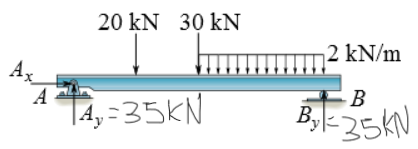Determine the bending moment function for the beam and draw its bending moment diagram.
Determine the bending moment function for the beam and draw its bending moment diagram.
Elements Of Electromagnetics
7th Edition
ISBN:9780190698614
Author:Sadiku, Matthew N. O.
Publisher:Sadiku, Matthew N. O.
ChapterMA: Math Assessment
Section: Chapter Questions
Problem 1.1MA
Related questions
Question
Determine the bending moment function for the beam and draw its bending moment diagram.

Transcribed Image Text:The image depicts a beam subjected to various forces and reactions. Here is a detailed description of the components:
1. **Beam AB**: The horizontal beam is supported at two points, A and B.
2. **Point Loads**:
- There is a 20 kN downward point load applied towards the left end of the beam.
- A 30 kN downward point load is located towards the middle of the beam.
3. **Distributed Load**:
- A uniformly distributed load (UDL) of 2 kN/m starts from the position of the 30 kN point load and extends to the right end of the beam.
4. **Supports**:
- At support A, there is a pin support allowing vertical and horizontal reactions. The vertical reaction is labeled \( A_y = 35 \) kN. The horizontal reaction is labeled \( A_x \).
- At support B, there is a roller support that allows only vertical reactions. The vertical reaction is labeled \( B_y = 35 \) kN.
5. **Equilibrium**: The reactions at supports \( A \) and \( B \) indicate that the beam is in static equilibrium, with reactions balancing the applied loads.

Transcribed Image Text:The image displays a shear force diagram for a beam, where the vertical axis represents the shear force \( V \) in kilonewtons (kN), and the horizontal axis represents the distance \( x \) in meters (m).
### Description of the Shear Force Diagram:
1. **Axes**:
- The vertical axis is labeled \( V \) (kN).
- The horizontal axis is labeled \( x \) (m).
2. **Plot Details**:
- The diagram begins at the origin.
- From 0 to 5 meters, the shear force is constant at 35 kN.
- At 5 meters, the shear force decreases to 0 kN.
- From 5 to 10 meters, the shear force is constant at 15 kN.
- At 10 meters, the shear force decreases to -15 kN.
- From 10 to 20 meters, the shear force linearly decreases to -35 kN.
3. **Critical Points**:
- (0, 35)
- (5, 35)
- (10, 15)
- (20, -35)
This diagram is crucial in structural analysis to understand how shear forces are distributed along the length of the beam, which helps in designing and assessing the structural integrity of the beam.
Expert Solution
Step 1: Given data
Determine the bending moment function for the beam and draw its bending moment diagram.


Step by step
Solved in 4 steps with 5 images

Knowledge Booster
Learn more about
Need a deep-dive on the concept behind this application? Look no further. Learn more about this topic, mechanical-engineering and related others by exploring similar questions and additional content below.Recommended textbooks for you

Elements Of Electromagnetics
Mechanical Engineering
ISBN:
9780190698614
Author:
Sadiku, Matthew N. O.
Publisher:
Oxford University Press

Mechanics of Materials (10th Edition)
Mechanical Engineering
ISBN:
9780134319650
Author:
Russell C. Hibbeler
Publisher:
PEARSON

Thermodynamics: An Engineering Approach
Mechanical Engineering
ISBN:
9781259822674
Author:
Yunus A. Cengel Dr., Michael A. Boles
Publisher:
McGraw-Hill Education

Elements Of Electromagnetics
Mechanical Engineering
ISBN:
9780190698614
Author:
Sadiku, Matthew N. O.
Publisher:
Oxford University Press

Mechanics of Materials (10th Edition)
Mechanical Engineering
ISBN:
9780134319650
Author:
Russell C. Hibbeler
Publisher:
PEARSON

Thermodynamics: An Engineering Approach
Mechanical Engineering
ISBN:
9781259822674
Author:
Yunus A. Cengel Dr., Michael A. Boles
Publisher:
McGraw-Hill Education

Control Systems Engineering
Mechanical Engineering
ISBN:
9781118170519
Author:
Norman S. Nise
Publisher:
WILEY

Mechanics of Materials (MindTap Course List)
Mechanical Engineering
ISBN:
9781337093347
Author:
Barry J. Goodno, James M. Gere
Publisher:
Cengage Learning

Engineering Mechanics: Statics
Mechanical Engineering
ISBN:
9781118807330
Author:
James L. Meriam, L. G. Kraige, J. N. Bolton
Publisher:
WILEY